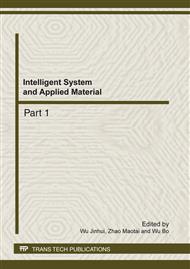[1]
L.M. Pecora, T.L. Carroll, Synchronization in chaotic systems, Phys Rev Lett, 1990, 64, p: 821-824.
DOI: 10.1103/physrevlett.64.821
Google Scholar
[2]
T. Stojanovski, L. Kocarev, U. Parlitz. Driving and synchronizing by chaotic impulses,. Physics Review E, 1996(54), p: 2128-2131.
DOI: 10.1103/physreve.54.2128
Google Scholar
[3]
S. Sivaprakasam, E.M. Shahverdiev, P.S. Spencer, Experimental demonstration of anticipating synchronization in chaotic semiconductor lasers with optical feedback, Physics Review Letters, 2001(87), p: 154101-154104.
DOI: 10.1103/physrevlett.87.154101
Google Scholar
[4]
C. Masoller, Anticipation in the synchronization of chaotic semiconductor lasers with optical feedback, Phys Rev Lett, 2001(86), p: 2782-2785.
DOI: 10.1103/physrevlett.86.2782
Google Scholar
[5]
Feki, Moez, An adaptive chaos synchronization scheme applied to secure communication,. Chaos, Solitons & Fractals, 2003(18), p: 141-148.
DOI: 10.1016/s0960-0779(02)00585-4
Google Scholar
[6]
T.L. Liao, S.H. Tsai, Adaptive synchronization of chaotic systems and its application to secure communications,. Chaos, Solitons & Fractals, 2000(11), p: 1387-1396.
DOI: 10.1016/s0960-0779(99)00051-x
Google Scholar
[7]
A. Maritan, J.R. Banavar, Chaos, noise, and synchronization, Phys Rev Lett, 1994(72), p: 1451-1454.
DOI: 10.1103/physrevlett.72.1451
Google Scholar
[8]
L. Kocarev, U. Parlitz, General approach for chaotic synchronization with applications to communication, Phys Rev Lett, 1995(74), p: 5028-5031.
DOI: 10.1103/physrevlett.74.5028
Google Scholar
[9]
G. Alvarez, S. Li, Some basic cryptographic requirements for chaos-based cryptosystems, International Journal of Bifurcation and Chaos, 2006, 16(8), p: 2129-2151.
DOI: 10.1142/s0218127406015970
Google Scholar
[10]
V. Lakshmikantham, D. D. Bainov, and P. S. Simeonov, Theory of impulsive differential equations,. Singapore: World Scientific, (1989).
DOI: 10.1142/0906
Google Scholar
[11]
X.G. Wu, Z.X. Wang, Estimating parameters of chaotic systems synchronized by external driving signal, Chaos Solitons & Fractals, 2007(33), p: 558-594.
DOI: 10.1016/j.chaos.2006.01.051
Google Scholar
[12]
P.G. Vaidya, S. Angadi, Decoding chaotic cryptography without access to the superkey, Chaos Solitons & Fractals, 2003(17), p: 379-386.
DOI: 10.1016/s0960-0779(02)00377-6
Google Scholar
[13]
L. Liu, X.G. Wu, H.P. Hu, Estimating system parameters of Chua's circuit from synchronizing signal, Physics Letter A, 2004(324), p: 36-41.
DOI: 10.1016/j.physleta.2004.02.047
Google Scholar


